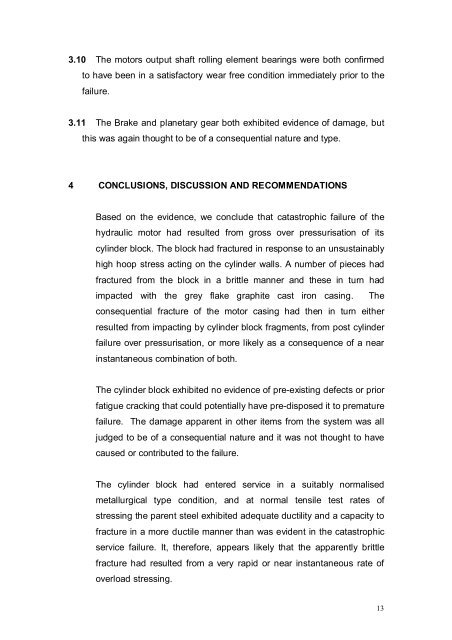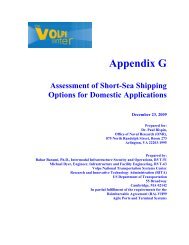Annexes - Marine Accident Investigation Branch
Annexes - Marine Accident Investigation Branch
Annexes - Marine Accident Investigation Branch
Create successful ePaper yourself
Turn your PDF publications into a flip-book with our unique Google optimized e-Paper software.
3.10 The motors output shaft rolling element bearings were both confirmed<br />
to have been in a satisfactory wear free condition immediately prior to the<br />
failure.<br />
3.11 The Brake and planetary gear both exhibited evidence of damage, but<br />
this was again thought to be of a consequential nature and type.<br />
4 CONCLUSIONS, DISCUSSION AND RECOMMENDATIONS<br />
Based on the evidence, we conclude that catastrophic failure of the<br />
hydraulic motor had resulted from gross over pressurisation of its<br />
cylinder block. The block had fractured in response to an unsustainably<br />
high hoop stress acting on the cylinder walls. A number of pieces had<br />
fractured from the block in a brittle manner and these in turn had<br />
impacted with the grey flake graphite cast iron casing. The<br />
consequential fracture of the motor casing had then in turn either<br />
resulted from impacting by cylinder block fragments, from post cylinder<br />
failure over pressurisation, or more likely as a consequence of a near<br />
instantaneous combination of both.<br />
The cylinder block exhibited no evidence of pre-existing defects or prior<br />
fatigue cracking that could potentially have pre-disposed it to premature<br />
failure. The damage apparent in other items from the system was all<br />
judged to be of a consequential nature and it was not thought to have<br />
caused or contributed to the failure.<br />
The cylinder block had entered service in a suitably normalised<br />
metallurgical type condition, and at normal tensile test rates of<br />
stressing the parent steel exhibited adequate ductility and a capacity to<br />
fracture in a more ductile manner than was evident in the catastrophic<br />
service failure. It, therefore, appears likely that the apparently brittle<br />
fracture had resulted from a very rapid or near instantaneous rate of<br />
overload stressing.<br />
13

















